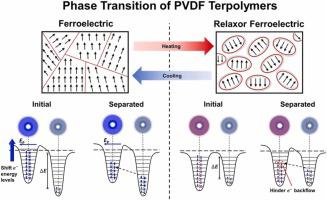Nano Energy ( IF 16.8 ) Pub Date : 2023-05-25 , DOI: 10.1016/j.nanoen.2023.108555 Daniel Tze Kheng Ong , Jason Soon Chye Koay , Moh Terng Sim , Kean Chin Aw , Takashi Nakajima , BingHui Chen , Swee Tiam Tan , Wee Chen Gan

|
Polyvinylidene difluoride (PVDF) polymers are widely used in triboelectric nanogenerators (TENGs) due to their excellent dielectric and piezoelectric properties. To design a high-performance TENG, it is essential to investigate the individual contributions of these properties on contact electrification (CE). In this work, a range of PVDF, co- and terpolymers are used to assess the distinct contributions of dielectric and piezoelectric properties on the TENG’s output. As elucidated by a modified overlapped electron cloud model (OEC) supported with Kelvin Probe Force Microscopy (KPFM) measurements, the high dielectric constant in terpolymers hinders electron backflow after CE, while piezoelectric polarization in β-phase PVDF shifts its electron energy levels before CE. Notably, in PVDF polymers, the dielectric and piezoelectric enhancements to TENGs come at the expense of one another. To verify this phenomenon, the terpolymers are cooled to alter their phases from relaxor to regular ferroelectrics, diminishing their dielectric constants while increasing their piezoelectric polarizations. Initially, the output is high (10.2 W/m2) at room temperature during the relaxor ferroelectric phase which is due to the high dielectric constant. Upon cooling, the output decreased to its lowest during the phase transition (4.3 W/m2 at 0 °C), as a result of the tradeoff between dielectric and piezoelectric enhancement. When the temperature was further tuned down to − 40 °C, the output reaches the maximum of 16 W/m2, which is attributed mainly to the ferroelectric phase. For the first time, the phase transition is observed and evidenced by electric field-induced dielectric and ferroelectric measurements, proving the piezoelectric polarization of PVDF terpolymers. These findings therefore provide guidelines on material selection and pave the way for potential low-temperature TENG applications.
中文翻译:

低温诱导相变实现的高性能复合 PVDF 摩擦纳米发电机
聚偏二氟乙烯 (PVDF) 聚合物由于其优异的介电和压电性能而广泛用于摩擦纳米发电机 (TENG)。要设计高性能 TENG,必须研究这些特性对接触带电 (CE) 的个别贡献。在这项工作中,使用一系列 PVDF、共聚物和三元共聚物来评估介电和压电特性对 TENG 输出的不同贡献。正如由开尔文探针力显微镜 (KPFM) 测量支持的改进重叠电子云模型 (OEC) 所阐明的那样,三元共聚物中的高介电常数阻碍了 CE 后的电子回流,而 β 中的压电极化相 PVDF 在 CE 之前改变其电子能级。值得注意的是,在 PVDF 聚合物中,TENG 的介电和压电增强是以牺牲彼此为代价的。为了验证这种现象,将三元共聚物冷却以将它们的相从弛豫改变为常规铁电体,从而降低它们的介电常数,同时增加它们的压电极化。最初,由于高介电常数,弛豫铁电相期间在室温下输出很高 (10.2 W/m 2 )。冷却后,输出在相变期间降至最低(4.3 W/m 2在 0 °C 时),这是介电增强和压电增强之间进行权衡的结果。当温度进一步调低至 − 40 °C 时,输出达到最大值 16 W/m 2,这主要归因于铁电相。首次通过电场诱导的介电和铁电测量观察和证明相变,证明了 PVDF 三元共聚物的压电极化。因此,这些发现为材料选择提供了指导,并为潜在的低温 TENG 应用铺平了道路。











































 京公网安备 11010802027423号
京公网安备 11010802027423号